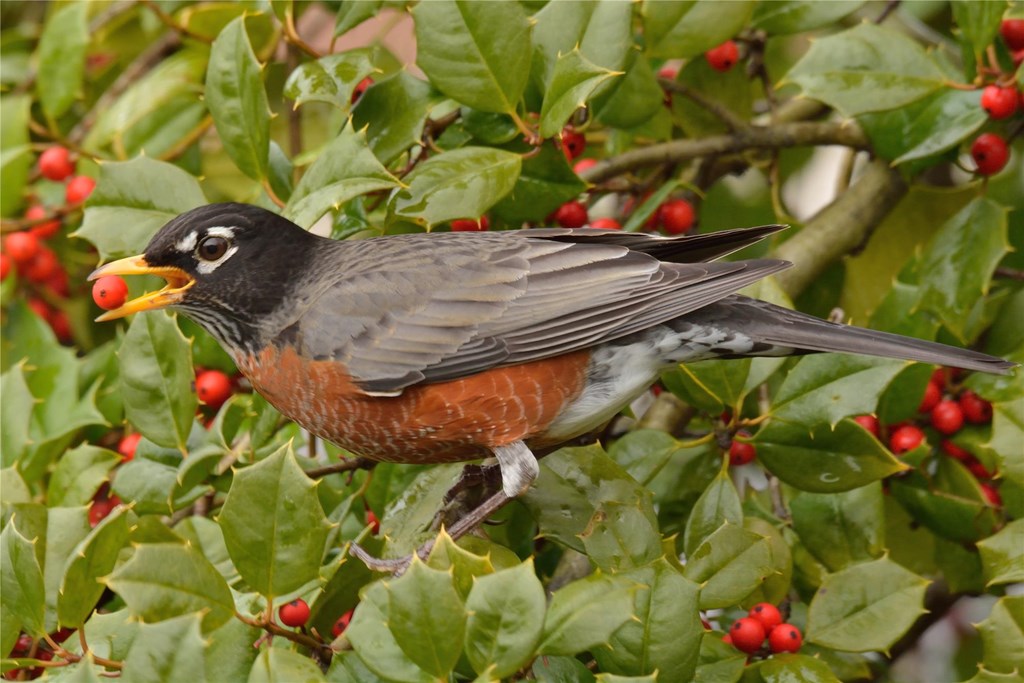On-site Studies

Hawk Mountain is an ideal site for long-term monitoring of bird populations. The Breeding Bird Census, Winter Bird Population Survey, and Christmas Bird Count all provide important information about population trends in birds, and can help to inform management decisions, scientific research questions, and the general public.
If you would like to volunteer for any of these projects, please contact Director of Conservation Science Dr. Laurie Goodrich at 570-943-3411 ext 106 or [email protected].
Support for these monitoring efforts is always appreciated. Use the button below to donate today, and be sure to include in the comments of the form that the online gift is for onsite monitoring.
Breeding Bird Census
Breeding Bird Census (BBC) is a standardized monitoring tool used to estimate breeding bird densities in specific habitat types throughout North America. Hawk Mountain Sanctuary is proud to have the oldest, continuous BBC site in Pennsylvania, and has been conducting counts on two long-term study plots since 1982. The program uses a technique called spot-mapping and is best suited for territorial species with relatively small home ranges. Censuses are conducted by staff or volunteers walking slowly through the plot and marking the location of all singing or calling birds on a map. Two censuses are conducted on each plot in late April to record early nesting species and an additional 8-10 censuses are conducted on each plot between May 15 and June 30th to record later nesting species. At the end of each breeding season an estimated number of territories per species is calculated.
Why it Matters
BBC’s help document the phenology, or timing of returning migrants as they establish their breeding territories. This type of consistent, annual monitoring is important because it allows us to compare our observations with other sites around the Eastern United States. BBC’s can also help us assess overall forest health by alerting us to declines in species that are dependent on healthy, contiguous tracts of forest.
Ruffed Grouse
Wild Turkey
Mourning Dove
Yellow-billed Cuckoo
Black-billed Cuckoo
Ruby-throated Hummingbird
Red-bellied Woodpecker
Downy Woodpecker
Hairy Woodpecker
Northern Flicker
Pileated Woodpecker
Eastern Wood-Pewee
Acadian Flycatcher
Eastern Phoebe
Great Crested Flycatcher
Red-eyed Vireo
Blue-headed Vireo
Blue Jay
American Crow
Tufted Titmouse
Black-capped Chickadee
White-breasted Nuthatch
Brown Creeper
Winter Wren
Blue-gray Gnatcatcher
Eastern Bluebird
American Robin
Wood Thrush
Hermit Thrush
Gray Catbird
Cedar Waxwing
Black-throated Green Warbler
Worm-eating Warbler
Black-and-white Warbler
American Redstart
Ovenbird
Common Yellowthroat
Hooded Warbler
Scarlet Tanager
Northern Cardinal
Rose-breasted Grosbeak
Indigo Bunting
Eastern Towhee
Brown-headed Cowbird
Baltimore Oriole
Total species recorded: 47
Winter Bird Population Study
Hawk Mountain has been conducting winter bird censuses on two long-term study plots from 1983 to 1988 and yearly since 1995. These censuses are part of the Winter Bird Population Study (WBPS), a monitoring program that estimates winter bird densities in specific habitat types throughout North America. Censuses are conducted by walking slowly through the plot and recording all birds seen or heard on a map of the plot. Censuses are conducted 8-12 times on each plot from 1 January to 28 February.
Why it Matters
Winter bird censuses, like breeding bird censuses, are intended to document the presence of birds in habitats unlikely to change, with the end result of assessing long-term population change in stable habitats.
Christmas Bird Count
The Christmas Bird Count (CBC) is a census of birds in the Western Hemisphere, performed annually in the early Northern-hemisphere winter by volunteer birdwatchers. Run by Audubon, CBC is “the nation’s longest running community science birds project,” having begun on Christmas Day in 1900. Each year on one day between December 14th and January 5th novice, intermediate, and advanced birders can join thousands of other volunteers and document their sightings. CBC differs from Winter Bird Counts in that this widely recognized project is intended to directly involve the public, is conducted on a single day, and entails counting birds within a 15 mile diameter circle.
Hawk Mountain staff members coordinate the Hamburg Area Christmas Bird Count which centers on the Pinnacle, a well-known landmark, and includes areas around Hamburg, Kempton, and New Ringgold as well as Gamelands 106 and Hawk Mountain Sanctuary. The Count was initiated in the 1960s and compiled by staff since the mid-1970s. Thirty to fifty volunteer counters cover the area each year and data are compiled for a record of early winter bird populations.
“When combined with other surveys such as Breeding Bird Survey, provides a picture of how the continent’s bird populations have changed in time and space over the past hundred years.”
-Audubon’s Christmas Bird Count website
North American Butterfly Count
This butterfly count takes place each summer around the 4th of July across the United States, Mexico, and Canada. This collaborative monitoring effort began in 1993 and has created a longterm database used by many conservationists to better understand butterfly populations, ranges, and flight patterns. The Hawk Mountain science team surveys across 9 plots on and around the Sanctuary.